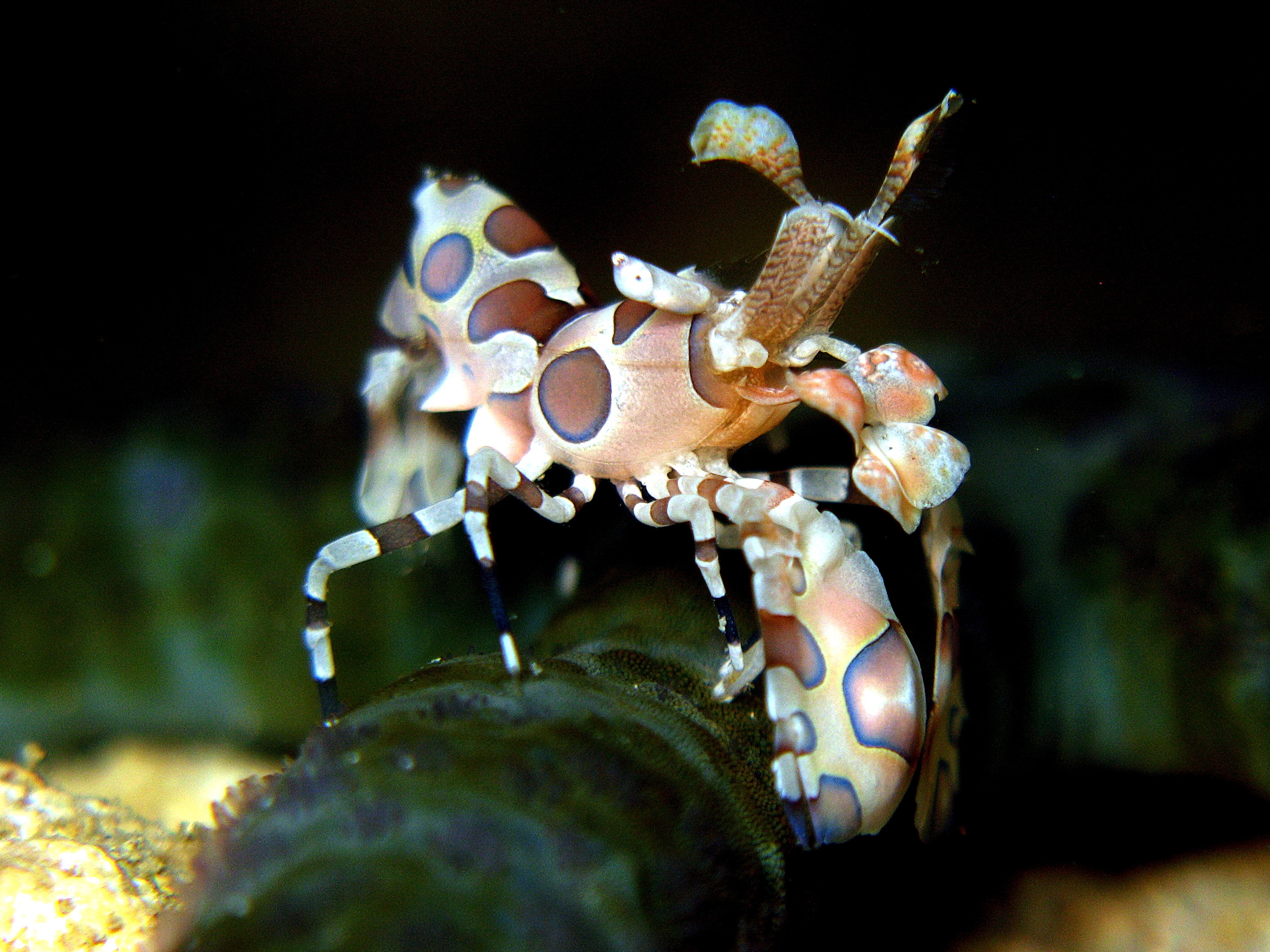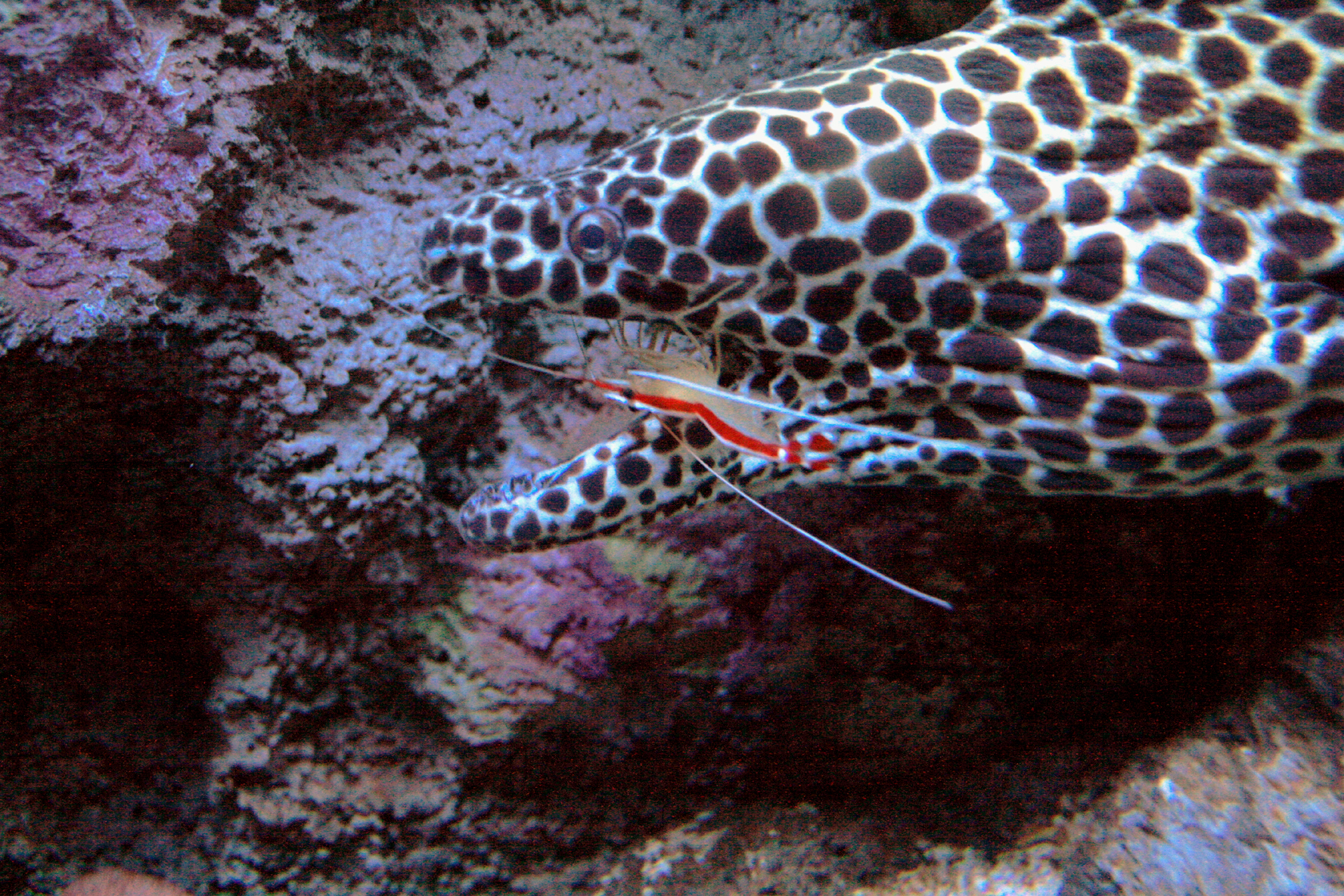|
Palaemonidae
Palaemonidae is a family of shrimp in the order Decapoda. Many species are carnivores that eat small invertebrates, and can be found in any aquatic habitat except the deep sea. One significant genus is ''Macrobrachium'', which contains commercially fished species. Others inhabit coral reefs, where they associate with certain invertebrates, such as sponges, cnidarians, mollusks, and echinoderms, as cleaner shrimps, parasites, or commensals. They generally feed on detritus, though some are carnivores and hunt tiny animals. The family contains more than 1200 species in 160 genera. The genera were formerly split into two subfamilies, but in 2015, molecular and morphological research determined that the subfamily groupings were invalid. At the same time, the members of the families Gnathophyllidae and Hymenoceridae were incorporated into the Palaemonidae. Genera The following genera are recognised: *'' Actinimenes'' *'' Alburnia'' *'' Allopontonia'' *'' Altopontonia'' *' ... [...More Info...] [...Related Items...] OR: [Wikipedia] [Google] [Baidu] |
List Of Palaemonidae Genera
These 163 genera belong to the family Palaemonidae, palaemonid shrimps. At least 1,200 described species are placed in the Palaemonidae. Palaemonidae genera * ''Actinimenes'' Duriš & Horká, 2017 * ''Allopontonia'' Bruce, 1972 * ''Altopontonia'' Bruce, 1990 * ''Amphipontonia'' Bruce, 1991 * ''Anapontonia'' Bruce, 1966 * ''Anchiopontonia'' Bruce, 1992 * ''Anchistus'' Borradaile, 1898 * ''Ancylocaris'' Schenkel, 1902 * ''Ancylomenes'' Okuno & Bruce, 2010 * ''Anisomenaeus'' Bruce, 2010 * ''Apopontonia'' Bruce, 1976 * ''Arachnochium'' N.g.Wowor, 2010 * ''Araiopontonia'' Fujino & Miyake, 1970 * ''Ascidonia'' Fransen, 2002 * ''Balssia'' Kemp, 1922 * ''Bathymenes'' Kou, Li & Bruce, 2016 * ''Blepharocaris'' Mitsuhashi & Chan, 2007 * ''Brachycarpus'' Bate, 1888 * ''Brucecaris'' Marin & Chan, 2006 * ''Bruceonia'' Fransen, 2002 * ''Cainonia'' Bruce, 2005 * ''Calathaemon'' Bruce & Short, 1993 * ''Carinopontonia'' Bruce, 1988 * ''Chacella'' Bruce, 1986 * ''Climeniperaeus'' Bruce, 1995 * ''Co ... [...More Info...] [...Related Items...] OR: [Wikipedia] [Google] [Baidu] |
Macrobrachium
''Macrobrachium'' is a genus of freshwater prawns or shrimps characterised by the extreme enlargement of the second pair of pereiopods, at least in the male. Species It contains these species: *'' Macrobrachium acanthochirus'' F. Villalobos, 1967 *'' Macrobrachium acanthurus'' (Wiegmann, 1836) *'' Macrobrachium acherontium'' Holthuis, 1977 *'' Macrobrachium adscitum'' Riek, 1951 *'' Macrobrachium aemulum'' (Nobili, 1906) *'' Macrobrachium agwi'' Klotz, 2008 *''Macrobrachium ahkowi'' Chong & Khoo, 1987 *'' Macrobrachium altifrons'' (Henderson, 1893) *''Macrobrachium amazonicum'' (Heller, 1862) *'' Macrobrachium americanum'' Spence Bate, 1868 *'' Macrobrachium amplimanus'' Cai & Dai, 1999 *''Macrobrachium andamanicum'' (Tiwari, 1952) *''Macrobrachium aracamuni'' Rodríguez, 1982 *''Macrobrachium asperulum'' (von Martens, 1868) *''Macrobrachium assamense'' (Tiwari, 1958) *''Macrobrachium atabapense'' S. Pereira, 1986 *''Macrobrachium atactum'' Riek, 1951 *''Macrobrachium auratu ... [...More Info...] [...Related Items...] OR: [Wikipedia] [Google] [Baidu] |
Caridea
The Caridea, commonly known as caridean shrimp or true shrimp, are an infraorder of shrimp within the order Decapoda. This infraorder contains all species of true shrimp. They are found widely around the world in both fresh and salt water. Many other animals with similar names – such as the mud shrimp of Axiidea and the boxer shrimp of Stenopodidea – are not true shrimp, but many have evolved features similar to true shrimp. Biology Carideans are found in every kind of aquatic habitat, with the majority of species being marine. Around a quarter of the described species are found in fresh water, however, including almost all the members of the species-rich family Atyidae and the Palaemonidae subfamily Palaemoninae. They include several commercially important species, such as ''Macrobrachium rosenbergii'', and are found on every continent except Antarctica. The marine species are found at depths to , and from the tropics to the polar regions. In addition to the great variety in ... [...More Info...] [...Related Items...] OR: [Wikipedia] [Google] [Baidu] |
Cleaner Shrimp
Cleaner shrimp is a common name for a number of swimming decapod crustaceans, that clean other organisms of parasites. They belong to any of three families, Hippolytidae (including the Pacific cleaner shrimp, ''Lysmata amboinensis''), Palaemonidae (including the spotted '' Periclimenes magnificus''), and Stenopodidae (including the banded coral shrimp, ''Stenopus hispidus'') . The last of these families is more closely related to lobsters and crabs than it is to the remaining families. The term "cleaner shrimp" is sometimes used more specifically for the family Hippolytidae and the genus ''Lysmata''. Cleaner shrimp are so called because they exhibit a cleaning symbiosis with client fish where the shrimp clean parasites from the fish. The fish benefit by having parasites removed from them, and the shrimp gain the nutritional value of the parasites. The shrimp also eat the mucus and parasites around the wounds of injured fish, which reduces infections and helps heali ... [...More Info...] [...Related Items...] OR: [Wikipedia] [Google] [Baidu] |
Periclimenes Pedersoni
''Ancylomenes pedersoni'', sometimes known as Pederson's shrimp and Pederson's cleaner shrimp, is a species of cleaner shrimp. It is part of the genus '' Ancylomenes'' and was described in 1958 by Fenner A. Chace Jr. as ''Periclimenes pedersoni''. ''Ancylomenes pedersoni'' is found in the Caribbean Sea, often associated with a sea anemone, at depths of . They are often found on the reefs off Bermuda. Description Pederson's shrimp is a small transparent shrimp with bluish and violet markings on the body and long white antennae and within its range is unlikely to be confused with other species. Ecology Pederson's shrimp lives in association with a sea anemone, either ''Bartholomea annulata'' or '' Condylactis gigantea'', living among the tentacles with impunity. Before it can do this it needs to acclimatise itself to the anemone by progressively pressing its body and appendages against the tentacles for increasing periods of time. After this it is able to move between the tentac ... [...More Info...] [...Related Items...] OR: [Wikipedia] [Google] [Baidu] |
Ancylomenes
''Ancylomenes'' is a genus of shrimp, erected in 2010 to accommodate the group of species around "''Periclimenes aesopius''" (now ''Ancylomenes aesopius''). Members of the genus are widely distributed in the warm oceans of the world, and live in association with cnidarians; most are cleaner shrimp. The genus ''Ancylomenes'' contains the following species: *'' Ancylomenes adularans'' (Bruce, 2003) *''Ancylomenes aesopius'' (Spence Bate, 1863) *''Ancylomenes amirantei'' (Bruce, 2007) *''Ancylomenes aqabai'' (Bruce, 2008) *''Ancylomenes grandidens'' (Bruce, 2005) *''Ancylomenes holthuisi'' (Bruce, 1969) *''Ancylomenes kobayashii'' (Okuno & Nomura, 2002) *''Ancylomenes kuboi'' Bruce, 2010 *''Ancylomenes longicarpus'' (Bruce & Svoboda, 1983) *''Ancylomenes lucasi'' (Chace, 1937) *''Ancylomenes luteomaculatus'' Okuno & Bruce, 2010 *''Ancylomenes magnificus'' (Bruce, 1979) *''Ancylomenes okunoi'' Bruce, 2010 *'' Ancylomenes pedersoni'' (Chace, 1958) *''Ancylomenes sarasvati'' (Okuno, 2 ... [...More Info...] [...Related Items...] OR: [Wikipedia] [Google] [Baidu] |
Allopontonia
''Allopontonia'' is a genus of shrimp in the family Palaemonidae, containing two species: *''Allopontonia alastairi'' Bruce, 2010 *''Allopontonia brockii'' (de Man, 1888) References External links''Allopontonia'': images & occurrence datafrom GBIF The Global Biodiversity Information Facility (GBIF) is an international organisation that focuses on making scientific data on biodiversity available via the Internet using web services. The data are provided by many institutions from around the .... Palaemonoidea Taxa named by Alexander James Bruce Crustaceans described in 1972 {{Caridea-stub ... [...More Info...] [...Related Items...] OR: [Wikipedia] [Google] [Baidu] |


